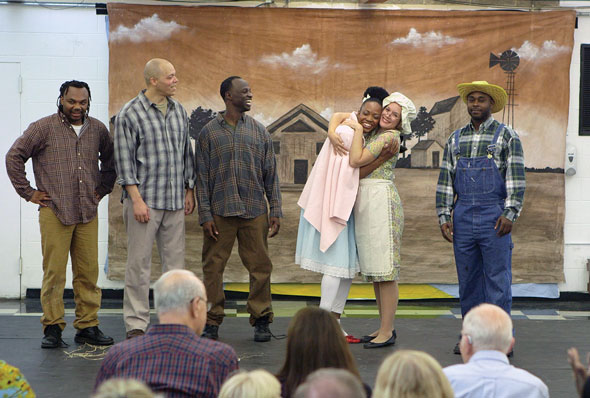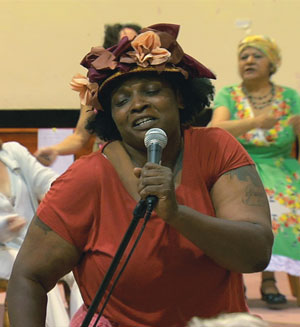
Shaquan Dunkin played the Cowardly Lion in a production of The Wizard of Oz at Sing Sing Correctional Facility. Before his performance, Dunkin hugged his mother, whom he hadn’t seen in seven years, and asked for forgiveness, which she gave amid tears.
The art of rehabilitation
Prison programs tap inmates’ creativity to spark transformation behind walls.
By Hans Hallundbaek
When Dorothy in The Wizard of Oz said, “There’s no place like home,” she surely wasn’t thinking of the place that’s “home” to Shaquan Dunkin. In fact, to Dunkin and roughly 1,600 other men, this “home” is more often called The Big House. It’s Sing Sing Correctional Facility, a fortresslike maximum-security prison 30 miles north of Manhattan. Surrounded by watchtower-topped concrete walls and miles of razor wire, Sing Sing is where many men will spend 10, 15, 20, or more years of their lives—even if they get out of prison eventually.
It’s the last place you’d expect to find Munchkins, wizards, and flying monkeys.
But on one day recently, Dunkin and 15 other inmates transformed the prison’s visitors’ room into the Land of Oz for a rousing performance of the classic. The play was produced by Rehabilitation Through the Arts (RTA), a nonprofit organization that organizes workshops and productions in theater, voice, music, writing, visual arts, and dance in five New York state prisons. RTA promotes the creative arts as a tool for social and cognitive transformation behind prison walls.
Hudson River Presbytery is closely affiliated with RTA and in fact has made prison ministry one of its priorities. The presbytery office is less than three miles from Sing Sing. Nearly 10 years ago the presbytery established Presbytery Prison Partnership (PPP) as a ministry and awareness-raising tool for its 82 congregations. PPP partners with transformative prison-related programs like RTA and is heavily engaged in creation of reentry programs for people returning to society after being incarcerated.

During the performance of The Wizard of Oz at Sing Sing, Dorothy hugs Aunt Em.

Left: A young man incarcerated at Sing Sing plays the Scarecrow, who thinks he lacks a brain. Right: Another man incarcerated at Sing Sing plays the Tin Man, who is seeking a heart.
“We are very happy that Presbyterian Prison Partnership has connected us with rehabilitative programs like RTA,” says Susan De George, stated clerk of Hudson River Presbytery. “It helps our congregations to recognize the humanity of those behind bars, facilitates concepts of second chances and redemption, and offers us concrete ways to build the more just world to which God calls us.”
Ministries like RTA are connected nationally through the Presbyterian Criminal Justice Network. Formed in 2012, the network is a response to the 219th General Assembly (2010) overture that requested the Presbyterian Mission Agency’s Presbyterian Health, Education, and Welfare Association bring together chaplains, ministers, and advocates to resource, organize, and coordinate prison ministry and efforts to end mass incarceration. Representatives of RTA were present for the very first gathering of the network at Stony Point Conference Center in New York.
Roots of rehabilitation
RTA traces its roots to Sing Sing, where members of the Rising Hope pre-college prison program suggested forming an art and theatrical troupe. Since its inception in 1996, RTA has become a nationally recognized nonprofit organization.

Rehabilitation Through the Arts participants perform modern dance for the prisoner population of Woodbourne Correctional Facility in southeastern New York.
“RTA is not about developing actors, but building community and unfolding hidden personal life skills, as stepping stones to academic education on the inside and job opportunities upon release,” says Katherine Vockins, founder and executive director of RTA.
Exposure to the arts has proven to stimulate social and intellectual growth and to help prepare individuals for academic training, Vockins says.
In addition, various studies have affirmed the value of arts programs in prisons. (See “Learn More.”)
Sing Sing Superintendent Michael Capra, a strong supporter of educational and rehabilitative efforts in prisons, sees a connection between programs like RTA’s and lower recidivism rates. He recently announced that at Sing Sing during the last 10 years the number of people re-incarcerated following a previous release has fallen from 60 percent to 43 percent.
Capra attributes the decrease to “progressive programming in education, vocational [training], and the arts.” Maintaining relationships with family also makes a big difference in success on the outside, he says.
Reunion and reconciliation
As the flagship program in Sing Sing, RTA produces a yearly three-evening theatrical production for the prison audience and on the last night attracts about 250 invited, carefully vetted community guests.

Women perform their original musical Amazing Grace at Bedford Hills Correctional Facility.
This year, prisoners’ families were allowed to attend the guest performance of the RTA theatrical production at Sing Sing for the first time.
For Shaquan Dunkin—who was portraying the Cowardly Lion—the drama began before he even set foot on the stage. As the cast prepared for the final night of the production, Dunkin paced nervously backstage. For seven years his mother had not visited him because of anger and shame over his crime. Through RTA, however, he learned that his mother would be in that night’s audience.
Like the character he would portray, Dunkin was tense, and he felt his courage slipping. What would he say to his mother? How would she react? His heart was pounding in his chest. Then suddenly a nearby steel door opened, and his mother approached—with arms wide open. The only words uttered were a muffled “I am so sorry.” A long and tear-drenched embrace followed, with a loving mother forgiving her remorseful son.
Off to the side, Vockins witnessed the tender reunion and said, “This is what rehabilitation is all about!”
Learn more
“Why Arts Programs in Prison Are So Important,” by the Council of State Governments Justice Center: csgjusticecenter.org
Prison ministry resources, provided by the Hudson River Presbytery Prison Partnership: hudrivpres.org
Rehabilitation Through the Arts: rta-arts.org
Presbyterian Criminal Justice Network: pcusa.org/phewa
That night, the Cowardly Lion gave his best performance, with his mother beaming and applauding from the front row. As the play moved toward its conclusion, audience members sat on the edges of their seats, with tissues in hand. Then the entire cast broke into a 30-second chant: “There is no place like home, there is no place like home, there is no place like home . . . .”
The next day, a member of the audience, Chris Shelton, reflected on the performance. Shelton, pastor of Broadway Presbyterian Church in New York City, said, “I have seen and read The Wizard of Oz so many times, but I can truly say that I encountered it anew at last night’s performance. For the first time, I felt the simple yearning of each of the characters—not only for home, brains, heart, and courage, but for wholeness, for renewed identity, for freedom.”
Hans Hallundbaek is the Presbytery Prison Partnership coordinator for Hudson River Presbytery. He is married to Katherine Vockins, executive director and founder of Rehabilitation Through the Arts.


